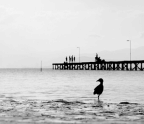The Surprising Story of Hubert Julian
 Illustration: Luis Pinto
Illustration: Luis Pinto Earlier this year, while researching a piece on the Guatemalan Revolution, I picked up the book Bitter Fruit about the 1954 US-backed coup d’état against Guatemala’s democratically-elected government. I learned that during the 1940s, the United States imposed a weapons embargo on Guatemala, which left it short of weaponry during the 1954 invasion. Then I came across a passage mentioning how Hubert Julian, a black man from Harlem, was the only American who defied Washington and sold guns to the Guatemalan government. I stopped in my tracks.
At the time, President Eisenhower’s government was persecuting alleged communists and their sympathizers. And so peddling weapons to the purported communist Guatemalan president, Jacobo Árbenz Guzmán, would have been considered an act of treason. When I reached out to one of the authors of Bitter Fruit to ask if he or his co-author had left anything out about Julian, he said he didn’t think so. But he did remember being surprised to find out that president Árbenz had help from Julian, who was not only an American, but “someone from the black community, which at the time was regularly controlled, persecuted, and oppressed.” Julian’s son, Mark Julian, echoes this remarkable fact about his father, “he did things no black man should’ve done, and very few white men could have done.”
After further research, I learned more aboutandhe also made appearances on and There is even a photograph of Julian at the New York State Public Library in Albany, shaking hands with Cassius Clay.
You’re reading a preview, subscribe to read more.
Start your free 30 days





